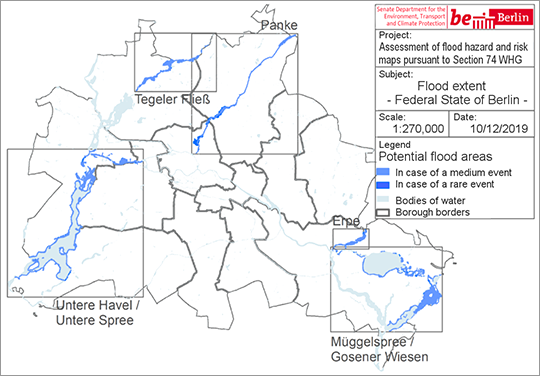The flood risk maps display the potential flood damage for three flood scenarios with a high, medium or low probability. They provide information on:
- the number of inhabitants that are potentially affected per risk area,
- adverse consequences to economic activity and land use of the affected areas
- adverse consequences to UNESCO World Heritage Sites and
- conservation districts that may be affected, e.g. drinking water protection areas and Natura 2000 areas.
The flood hazard maps and flood risk maps constitute an important tool in flood prevention and flood protection. On the one hand, they are intended for internal use by the authorities. They provide the basis for deriving measures as part of the Flood Risk Management Plan. In Berlin, flood areas are defined based on the flood hazard maps (SenStadt 2019c). In flood areas, building restrictions apply (Law and Ordinance Gazette p. 658ff, only in German), which then impact on planning and land use. Outside their application in flood areas, flood hazard maps represent the spatial backdrop for “risk areas” (cf. Article 78b para. 1 sentence 1 WHG). Relevant restrictions for fuel oil consumer installations also apply here.
On the other hand, flood hazard maps and flood risk maps serve to inform the public and to illustrate potential hazards and risks. They can be used as a basis to implement one’s own individual precautionary measures. The detailed hazard and risk maps can be accessed by the public via the “map presentation” in the Geoportal Berlin.
The map application National flood hazard maps and risk maps (only in German) is provided by the German Federal Institute of Hydrology (BfG) (BfG 2019a). It represents the national interface for hazard and risk maps throughout Germany according to the FRMD. In addition, the BfG provides a further map application on nationwide flood scenarios (BfG 2019b).

